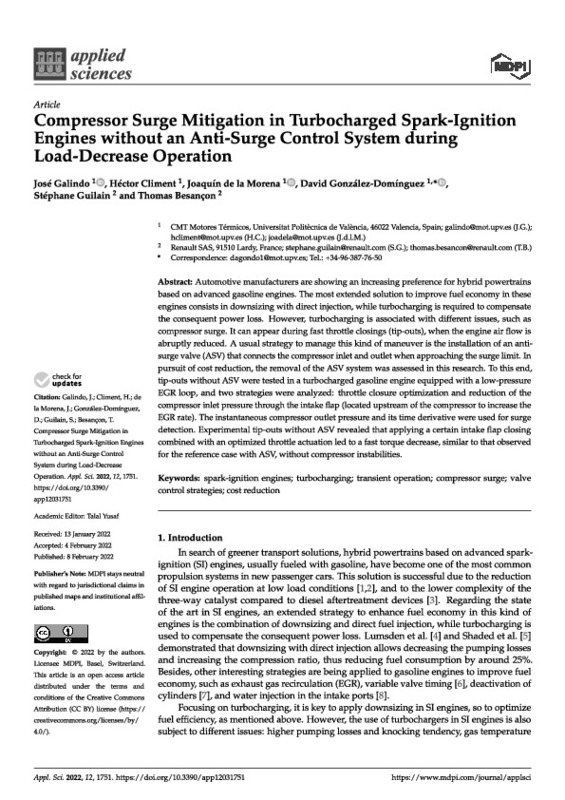JavaScript is disabled for your browser. Some features of this site may not work without it.
Buscar en RiuNet
Listar
Mi cuenta
Estadísticas
Ayuda RiuNet
Admin. UPV
Compressor Surge Mitigation in Turbocharged Spark-Ignition Engines without an Anti-Surge Control System during Load-Decrease Operation
Mostrar el registro sencillo del ítem
Ficheros en el ítem
| dc.contributor.author | Galindo, José
|
es_ES |
| dc.contributor.author | Climent, H.
|
es_ES |
| dc.contributor.author | De La Morena, Joaquín
|
es_ES |
| dc.contributor.author | González-Domínguez, David
|
es_ES |
| dc.contributor.author | Guilain, Stéphane
|
es_ES |
| dc.contributor.author | Besançon, Thomas
|
es_ES |
| dc.date.accessioned | 2023-06-13T18:02:51Z | |
| dc.date.available | 2023-06-13T18:02:51Z | |
| dc.date.issued | 2022-02 | es_ES |
| dc.identifier.uri | http://hdl.handle.net/10251/194177 | |
| dc.description.abstract | [EN] Automotive manufacturers are showing an increasing preference for hybrid powertrains based on advanced gasoline engines. The most extended solution to improve fuel economy in these engines consists in downsizing with direct injection, while turbocharging is required to compensate the consequent power loss. However, turbocharging is associated with different issues, such as compressor surge. It can appear during fast throttle closings (tip-outs), when the engine air flow is abruptly reduced. A usual strategy to manage this kind of maneuver is the installation of an anti-surge valve (ASV) that connects the compressor inlet and outlet when approaching the surge limit. In pursuit of cost reduction, the removal of the ASV system was assessed in this research. To this end, tip-outs without ASV were tested in a turbocharged gasoline engine equipped with a low-pressure EGR loop, and two strategies were analyzed: throttle closure optimization and reduction of the compressor inlet pressure through the intake flap (located upstream of the compressor to increase the EGR rate). The instantaneous compressor outlet pressure and its time derivative were used for surge detection. Experimental tip-outs without ASV revealed that applying a certain intake flap closing combined with an optimized throttle actuation led to a fast torque decrease, similar to that observed for the reference case with ASV, without compressor instabilities. | es_ES |
| dc.language | Inglés | es_ES |
| dc.publisher | MDPI AG | es_ES |
| dc.relation.ispartof | Applied Sciences | es_ES |
| dc.rights | Reconocimiento (by) | es_ES |
| dc.subject | Spark-ignition engines | es_ES |
| dc.subject | Turbocharging | es_ES |
| dc.subject | Transient operation | es_ES |
| dc.subject | Compressor surge | es_ES |
| dc.subject | Valve control strategies | es_ES |
| dc.subject | Cost reduction | es_ES |
| dc.subject.classification | MAQUINAS Y MOTORES TERMICOS | es_ES |
| dc.title | Compressor Surge Mitigation in Turbocharged Spark-Ignition Engines without an Anti-Surge Control System during Load-Decrease Operation | es_ES |
| dc.type | Artículo | es_ES |
| dc.identifier.doi | 10.3390/app12031751 | es_ES |
| dc.rights.accessRights | Abierto | es_ES |
| dc.contributor.affiliation | Universitat Politècnica de València. Escuela Técnica Superior de Ingeniería del Diseño - Escola Tècnica Superior d'Enginyeria del Disseny | es_ES |
| dc.description.bibliographicCitation | Galindo, J.; Climent, H.; De La Morena, J.; González-Domínguez, D.; Guilain, S.; Besançon, T. (2022). Compressor Surge Mitigation in Turbocharged Spark-Ignition Engines without an Anti-Surge Control System during Load-Decrease Operation. Applied Sciences. 12(3):1-15. https://doi.org/10.3390/app12031751 | es_ES |
| dc.description.accrualMethod | S | es_ES |
| dc.relation.publisherversion | https://doi.org/10.3390/app12031751 | es_ES |
| dc.description.upvformatpinicio | 1 | es_ES |
| dc.description.upvformatpfin | 15 | es_ES |
| dc.type.version | info:eu-repo/semantics/publishedVersion | es_ES |
| dc.description.volume | 12 | es_ES |
| dc.description.issue | 3 | es_ES |
| dc.identifier.eissn | 2076-3417 | es_ES |
| dc.relation.pasarela | S\469333 | es_ES |








